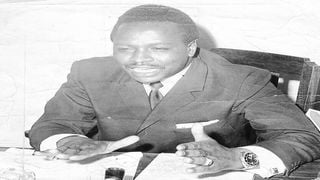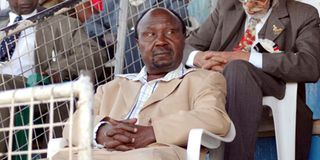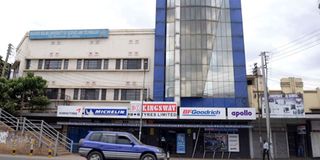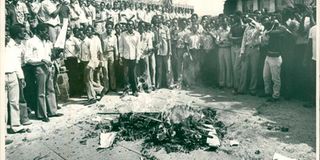
Late politician J.M. Kariuki.
| File | Nation Media GroupNews
Premium
JM Kariuki: 46 years later, murder and mystery at Kingsway House
What you need to know:
- When news of JM’s disappearance broke, Vice President Moi told Parliament that he was alive in Zambia.
- The next day, he would face the wrath of MPs after the body was identified at the City Mortuary.
- Apart from Mwai Kibaki, who told mourners that he attended the funeral as a friend of the family, no other Cabinet minister went to Gilgil to bury JM.
Forty-six years ago today, populist politician JM Kariuki was taking tea at the Hilton Hotel when powerful General Service Unit (GSU) Commandant Ben Gethi walked in. He was just about to betray a friend.
The two, after a brief chat, walked out together and JM was never seen alive again. His badly decomposed body would be found in the Ngong Forest by a herdsman and taken to City Mortuary where it was booked in as “unidentified adult male.”
The Maasai herdsman who discovered JM's body behind Ngong Hills (left). A herder points to where his body was found (right).
JM had many political and business enemies.
At the Hilton Hotel that day, JM had had an interview, nay, talk, with a Reuters correspondent, Michael Malik, and lamented about Kenyan politics and how, during the last General Election, he had been stopped from campaigning.
He had later published a pamphlet that denounced some big shots whom he claimed had seized the whole economy to exploit the common man.
“It is unjust for a few men with rank, opportunity, and power to use these opportunities to make profits from the wealth of the whole country and make away with money, real estate, big business and thousands of acres of land,” said JM in the pamphlet, later quoted by the Tanzanian newspaper, Uhuru.
Irony of his wealth
While Mr Kariuki stood for the poor on the political podium, he was immensely wealthy – and had made his money through some unorthodox means that included trading in ivory with some Gikuyu, Embu and Meru Association (Gema) barons and as a front for Israeli businessman Ernest Kahane. As money flowed in, his presidential ambitions rose, much to the chagrin of insiders in the Jomo Kenyatta government.
As assistant minister for tourism and wildlife, JM, as he was popularly known, had grown rich, with many doubting the source of his money, which he dished out at the many harambees that he held all over the country.
In this undated photo, late politician J.M. Kariuki (left) is seen when he was Assistant Minister for Tourism and Wildlife with members of the Rusinga Welfare Association.
Many thought his contributions were the source of political hatred towards him. The matter was first raised in Parliament in 1970, when Minister of State Mbiyu Koinange was asked why he had cancelled several harambee meetings where JM was the guest of honour.
Although Parliament was given three specific incidents, Koinange claimed he was “not aware.”
Former Minister of State Mbiyu Koinange.
Aware that Koinange was not about to explain, vocal MP Kassim Mwamzandi insinuated: “The minister is jealous.”
As MP for Nyandarua North, Mr Kariuki had been one of the most vocal MPs in Kenya, though he was also close to President Kenyatta. For that closeness, he had been appointed Kenyatta’s private secretary in the early years of Kenya’s self-rule and later as an assistant minister.
Mossad links
But it was his dalliance with Israeli intelligence that would place him as one of the politicians trusted by the Mossad and he managed to broker the training of key intelligence officials in Kenya and the setting up of the National Youth Service (NYS) by the Israelis.
By seeking scholarships for various intelligence personnel, JM was thought to be privately building his own network. The NYS, where he would demand to inspect guard of honour, had become his own playground.
NYS leader JM Kariuki (left) and then Labour Minister Julius Gikonyo Kiano (in glasses) meet new NYS recruits from North-Eastern Province at Dagenham Road (later renamed Dunga Road) on January 20, 1966.
A man with a string of directorships in various companies and with interest in gemstone mining and farming, JM would earn enemies for his loud mouth and populist stance – especially on land, which was being grabbed by the rich.
“Kariuki himself had tried to purchase extensive parcels of land in the area at the expense of those still without acreage but met with opposition from foreign purchasers and Kiambu-based land-buying companies,” claims Prof Jennifer A Widner in her book The Rise of a Party-State in Kenya: From "Harambee!" to "Nyayo!"
With Jaramogi Oginga Odinga and Bildad Kaggia silenced after they loudly complained about land redistribution, JM was the only politician left inside Parliament and the ruling party Kanu, who would still raise the matter.
More so, his generosity was treated as political show-off by his detractors. On the 10th anniversary of Kenya’s independence, as Kenyatta was telling the nation of his achievements, JM told Parliament that the country was becoming a nation of 10 millionaires and 10 million beggars.
Those who disliked JM hardly hid their disdain.
For instance, one evening in December 1974 at Nakuru’s Stags Head hotel, JM was having a drink with Nakuru Town MP Mark Mwithaga, when Kenyatta’s eldest son, Peter Muigai, entered the hotel accompanied by the garrulous Nakuru mayor, Mburu Gichua.

Former Nakuru Town MP Mark Mwithaga.
As Mwithaga later recounted, they minced no words while pointing at JM: “You have brought trouble here from Nyandarua. Be warned; this is Nakuru and we can finish you at any time!”
As Mwithaga told a local newspaper “Muigai and Gichua never even bothered to say hello to us. They just lectured JM and left. We were very, very shocked.”
Peter Muigai (left), eldest son of Jomo Kenyatta.
Difficulties reaching Kenyatta
Kenyatta’s inner circle – and the political power brokers who were mesmerised by newfound wealth – had made sure that JM never reached State House. The more he was cut from the centre, the angrier he grew at the cabal.
Mwithaga, who was JM’s close friend, was the first to suffer for the association when Attorney-General Charles Njonjo retrieved an old minor domestic scuffle case and had Mwithaga charged with assault. He was eventually jailed for one year and he lost his seat.
A month before he was killed, JM is said to have chatted with one of the influential members of Gema, Njenga Karume.
President Jomo Kenyatta and Mama Ngina sit with the National Gema Chairman, Mr Njenga Karume (left), as they watch traditional dancers at his Gatundu home on November 1975.
As Karume later recounted, “JM looked disturbed. He was not the confident man I knew. He began by thanking me for having stood by him in 1974 when a powerful clique wanted Gema to campaign against him in the 1974 elections. Then he told me of the plot against his life and his difficulties in reaching Kenyatta.”
Maskini Liberation Organisation
The 1974 General Election had revealed growing dissatisfaction with the Kenyatta administration and a shadowy group known as Maskini Liberation Organisation had emerged to, ostensibly, fight for the poor. The intelligence apparatus had linked JM to this group, as leaflets with the movement’s letterheads, popped up everywhere with JM Kariuki and Charles Rubia listed as trustees.
When a bomb exploded in early February 1975 at the Starlight Nightclub, then located where Integrity Centre currently stands, it was blamed on Maskini. Another explosion occurred at the Tourist Information Office, next to the Hilton Hotel.
According to published reports, Embu East MP Njagi Mbarire asked the Vice-President and minister for Home Affairs, Mr Daniel arap Moi, to tell Parliament who was behind Maskini. But Kamukunji MP Maina Wanjigi said Moi was unable to explain because Maskini was a creation of the intelligence.
So, was somebody out to portray JM as a violent man – or was he, indeed, the man behind the series of bombings in Nairobi? That question has never been answered.
What we know is that a day before JM disappeared, a massive bomb exploded at the city’s OTC bus station, killing 27 people and injuring more than 100.
It is claimed that JM’s killing was timed to coincide with the blast so that he could be buried among the unidentified. Other intelligence sources claim that the OTC bus was carrying Maskini Liberation Organisation members and they were targeted by intelligence.
It was also reported that on Friday, February 28, JM had been booked onto a Mombasa-bound bus to escape the bombings in Nairobi. On the evening of March 1, the bomb exploded. That morning, the 28‐storey Kenyatta International Conference Centre had to be cordoned off after a hoax caller claimed that a bomb had been planted at the United Nations Environment Programme offices.
But whether these incidents explain why JM was picked up by the police chief at Hilton on March 2, 1975, is not clear, because Gethi refused to be interrogated by the Parliamentary Select Committee set up to investigate the murder.
General Service Unit (GSU) Commandant Ben Gethi.
Fingers have always pointed at Wanyoike Thungu, an easily irritated man who usually posed as Kenyatta’s bodyguard and was part of the Kiambu “mafia”.
In this undated photo, Mzee Kenyatta (seated) receives a cheque from John Keen (left). Also present is Arthur Wanyoike Thungu (next to Kenyatta) and the then Kiambu DC (in uniform).
What we now know: A deconstruction
What we now know is that JM was whisked to the Special Branch headquarters at Kingsway House on Muindi Mbingu Street where he met the Criminal Investigations Department director Ignatius Nderi together with the man JM hated – Thungu.
Former CID director Ignatius Nderi.

Kingsway building (left), which was the former CID headquarters.
Why JM was picked up by the GSU boss and not the Police Commissioner could be an indicator to the interrogation being about other dealings.
While the interrogation centred on the mysterious bombings, according to published accounts, there was also a conversation on some money that JM owed members of the inner circle. It was also claimed that JM was tasked to explain the whereabouts of Mau compensation money – and that is when tempers flared, and he was shot.
While these accounts have never been corroborated – they are the only explanations available on what transpired at the CID headquarters.
JM had arrived at the Hilton Coffee House at 6.45 on Sunday evening. He still had his pistol, given to him the previous day by Gethi. He had called his wife in Gilgil and informed her about the meeting with Gethi.
Perhaps due to the trust he had in Gethi, JM willingly got into Gethi’s Peugeot 504, leaving his Mercedes Benz registration number KPE 153 in the parking lot outside the hotel. Chances are he thought he would be back for it.
But before JM arrived at the Hilton Hotel, some police reservists, including the infamous Patrick Shaw, had been spotted hovering around the hotel, chasing away taxi drivers and parking boys.
The late police reservist Patrick Shaw.
Others who appeared at the hotel were Nderi and then-deputy director of the National Youth Service Waruhiu Itote -- who had been trained in Israel, thanks to JM. Also mentioned by the Select Committee was a Mr John Mutungu of Olkejuado County Council. It was said that his vehicle was used to dump JM’s body but police did not follow up the lead.
There are other accounts that police had hired Nairobi businessman Pius Kibathi, a trained policeman who never joined the force, to keep a close eye on JM, together with a known criminal, “Mark Twist.”
'Alive in Zambia'
When news of JM’s disappearance broke, Vice President Moi told Parliament that he was alive in Zambia. The next day, he would face the wrath of MPs after the body was identified at the City Mortuary. JM’s watch would later be found in the police lines.
In a bid to silence a bitter nation, Moi had suggested to Kenyatta that an inquiry be set up to investigate the murder. That would help cool down tempers and riots, especially at the University of Nairobi.

University of Nairobi students after burning copies of the Daily Nation after it reported that J.M. Kariuki was in Zambia on business. His mutilated body was later identified by his wife at City Mortuary.
Apart from Mwai Kibaki, who told mourners that he attended the funeral as a friend of the family, no other Cabinet minister went to Gilgil to bury JM. An attempt by Provincial Commissioner Simeon Nyachae to read Kenyatta’s condolence message was drowned out by boos from the mourners.
Then Minister Mwai Kibaki has a word with Terry Kariuki (left), wife of the late JM Kariuki, and Josephine Muthoni, a Nairobi trader, during a harambee.
But efforts by the Select Committee to summon key members of Kenyatta’s inner circle failed and on June 11, the team finally tabled its report to the House. It was debated for four days and an attempt by the government to water down the report was defeated by a 62-59 margin, with Masinde Muliro (minister for Works) and assistant ministers John Keen and Peter Kibisu voting with the backbenchers.
Asked why he voted against the government, Keen explained that there “is no collective responsibility in murder.”
Three Cabinet ministers, Mwai Kibaki, Gikonyo Kiano and Isaac Omolo-Okero skipped the vote and almost lost their positions. While Kenyatta fired Muliro, Keen and Kibisu, he did not take any steps against the police officers and politicians mentioned in the saga.
But Kenyatta was known to fail to take any steps while under pressure, fearing it could be interpreted as a sign of weakness.
And with failing health, it is speculated that the police officers – most of them in their 40s – took advantage of Mzee Kenyatta’s advanced age.
Although the parliamentary committee that probed the murder of JM recommended that Councillor Mutungu be investigated alongside Thungu, Koinange, his bodyguard Peter Karanja, Gichua, then Nyandarua District Commissioner Stanley Thuo, Itote and JM’s rival in the 1974 General Election, Evans Ngugi, nothing happened.
Some 46 years later, Kenyans still speculate on why one of the nation’s most vocal and flamboyant politicians was killed.
To date, despite promises, there has been no solid attempt to unravel a murder that still stands out in the history of assassinations in the country.
The murder inside Kingsway House, Nairobi, still remains a mystery.

One of JM's widows, Doris, with children, Mark (left) John (right) and daughter-in-law Dorcas Njeri.





